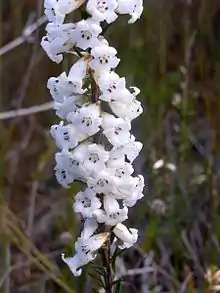Epacris obtusifolia
Epacris obtusifolia is common plant from the heath family. The blunt-leaf heath grows in swampy areas and heathland in eastern Australia. It is usually seen growing less than a metre tall. Flowers form in any time of the year, but are mostly seen between July and January.
| Blunt-leaf heath | |
|---|---|
 | |
| Ku-ring-gai Chase National Park, Australia | |
| Scientific classification | |
| Kingdom: | Plantae |
| Clade: | Tracheophytes |
| Clade: | Angiosperms |
| Clade: | Eudicots |
| Clade: | Asterids |
| Order: | Ericales |
| Family: | Ericaceae |
| Genus: | Epacris |
| Species: | E. obtusifolia |
| Binomial name | |
| Epacris obtusifolia | |
The specific epithet obtusifolia is derived from Latin, referring to the thickly tipped blunt leaves.[1] The original specimen was collected in Sydney in the early colonial years. And it was first recorded in scientific literature in the year 1805, published by the eminent English botanist James Edward Smith.[2]
Growing up to a metre (3 ft) tall (though mostly 50–80 cm high), Epacris obtusifolia is a dainty shrub with tiny elliptic leaves which measure 6.4 to 11.5 mm long and 1.5 to 3.1 mm wide. Appearing mainly from July to January, the white bell-shaped flowers are arranged along the stems.[3] Although only 4–8 mm long, their numbers make them conspicuous.[4]
Found in New South Wales east of the Great Dividing Range, as well as Queensland, Victoria and Tasmania, Epacris obtusifolia is found in wet heathland.[3] In the Sydney region it is associated with such plants as coral fern (Gleichenia dicarpa), swamp banksia (Banksia robur), and the sedge Lepidosperma limicola.[5] Plants live between ten and twenty years, and are killed by fire and regenerate from seed which lies dormant in the soil. The seedlings reach flowering age within four years.[5]
Epacris obtusifolia can be propagated by cutting and requires a well-drained yet moist position in the garden.[6] It was first cultivated in the United Kingdom in 1804.[7]
References
- Les Robinson - Field Guide to the Native Plants of Sydney, ISBN 978-0-7318-1211-0 page 107
- "Epacris obtusifolia Sm". Australian Plant Name Index (APNI), IBIS database. Centre for Plant Biodiversity Research, Australian Government.
- J. M. Powell. "New South Wales Flora Online: Epacris obtusifolia". Royal Botanic Gardens & Domain Trust, Sydney, Australia.
- Fairley, Alan; Moore, Philip (2000). Native Plants of the Sydney District:An Identification Guide (2nd ed.). Kenthurst, NSW: Kangaroo Press. p. 93. ISBN 0-7318-1031-7.
- Benson, Doug; McDougall, Lyn (1995). "Ecology of Sydney Plants 3: families Cabombaceae to Eupomatiaceae" (PDF). Cunninghamia. 4 (2): 217–429. Archived from the original (PDF) on 2016-03-13. Retrieved 2016-12-23.
- Walters, Brian (June 2010). "Epacris obtusifolia". Australian Native Plants Society. Retrieved 2 October 2011.
- Elliot RW, Jones DL, Blake T (1984). Encyclopaedia of Australian Plants Suitable for Cultivation:Volume 3 - Ce-Er. Port Melbourne: Lothian Press. p. 416. ISBN 0-85091-167-2.